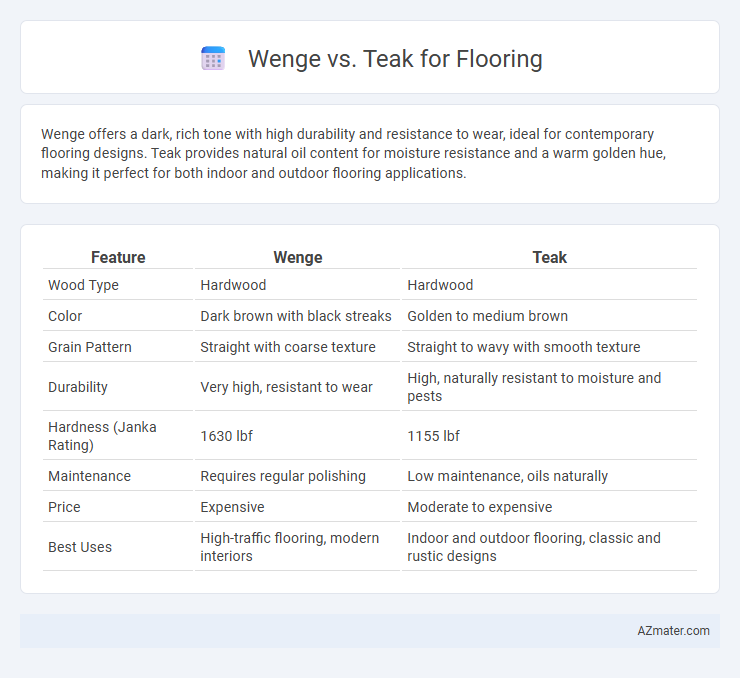Wenge offers a dark, rich tone with high durability and resistance to wear, ideal for contemporary flooring designs. Teak provides natural oil content for moisture resistance and a warm golden hue, making it perfect for both indoor and outdoor flooring applications.
Table of Comparison
| Feature | Wenge | Teak |
|---|---|---|
| Wood Type | Hardwood | Hardwood |
| Color | Dark brown with black streaks | Golden to medium brown |
| Grain Pattern | Straight with coarse texture | Straight to wavy with smooth texture |
| Durability | Very high, resistant to wear | High, naturally resistant to moisture and pests |
| Hardness (Janka Rating) | 1630 lbf | 1155 lbf |
| Maintenance | Requires regular polishing | Low maintenance, oils naturally |
| Price | Expensive | Moderate to expensive |
| Best Uses | High-traffic flooring, modern interiors | Indoor and outdoor flooring, classic and rustic designs |
Introduction to Wenge and Teak Flooring
Wenge flooring features a rich, dark brown color with distinctive black streaks, offering a bold and exotic aesthetic that enhances contemporary and classic interiors. Teak flooring is renowned for its durability, natural oils, and warm golden-brown tones, making it a popular choice for both indoor and outdoor applications due to its resistance to moisture and wear. Both hardwoods are prized for their unique grain patterns and longevity, providing high-quality alternatives for stylish and long-lasting flooring solutions.
Origin and Botanical Background
Wenge originates from the Millettia laurentii tree native to Central Africa, characterized by its deep, dark brown color with subtle black streaks, while Teak comes from the Tectona grandis tree, native to South and Southeast Asia, known for its golden-brown hues and high oil content. Botanically, Wenge belongs to the Fabaceae family, valued for its dense, coarse grain and durability, whereas Teak is part of the Lamiaceae family, prized for its natural resistance to moisture, insects, and decay. Both woods are highly sought after for premium flooring due to their unique aesthetics and robust botanical properties.
Visual Appearance and Color Differences
Wenge flooring features a rich, dark brown to almost black hue with distinctive, fine grain patterns that create a dramatic and modern aesthetic. Teak showcases warm golden to medium brown tones with a natural, smooth grain and subtle reddish undertones, offering a classic and inviting appearance. The contrast in color depth and grain texture between Wenge and Teak makes Wenge ideal for bold, contemporary interiors, while Teak suits traditional or tropical-inspired designs.
Hardness and Durability Comparison
Wenge flooring ranks high on the Janka hardness scale, measuring around 1630, making it highly resistant to dents and wear in high-traffic areas. Teak wood scores slightly lower at approximately 1155 on the Janka scale but compensates with exceptional natural oils that enhance its durability and resistance to moisture and decay. Both hardwoods provide long-lasting flooring solutions, with Wenge excelling in hardness and Teak offering superior resilience against environmental factors.
Resistance to Moisture and Termites
Wenge flooring exhibits outstanding resistance to moisture due to its dense grain structure, making it highly durable in humid environments. Teak also offers excellent moisture resistance thanks to its natural oils that repel water and prevent warping. In terms of termite resistance, both woods are naturally resistant, but teak's high natural oil content provides superior protection against insect infestation.
Maintenance and Long-Term Care
Wenge flooring requires regular dusting and occasional polishing to maintain its deep, rich color, with care needed to prevent scratches due to its hardness level of 4 on the Janka scale. Teak flooring boasts superior natural oil content, reducing the need for frequent maintenance and providing excellent resistance to moisture and pests, making it ideal for long-term durability. Both woods benefit from proper sealing and avoiding prolonged exposure to direct sunlight to preserve their appearance over time.
Installation Process and Considerations
Wenge flooring requires precise acclimation due to its dense, moisture-sensitive nature, demanding professional installation with specialized tools to prevent splitting and warping. Teak offers more installation flexibility, tolerating slight moisture variations and allowing both nail-down and floating methods, making it a preferred choice for DIY enthusiasts and high-moisture areas. Proper subfloor preparation and moisture barriers are critical for both, but Wenge's hardness necessitates careful handling to maintain durability and aesthetic appeal.
Cost and Value for Money
Wenge flooring typically costs between $8 and $12 per square foot, offering a unique dark tone prized for its durability and resistance to wear, which enhances long-term value despite a higher initial price. Teak flooring ranges from $6 to $11 per square foot and is renowned for its natural oils that provide water resistance and longevity, making it a cost-effective choice when factoring in maintenance and lifespan. Both woods provide excellent investment returns, with Wenge's striking aesthetic and Teak's proven resilience delivering strong value for money depending on design preference and budget.
Environmental Impact and Sustainability
Wenge flooring, harvested primarily from Central African rainforests, presents environmental concerns due to deforestation risks and slower growth rates, impacting its sustainability. Teak, sourced from Southeast Asia, benefits from well-developed plantation programs promoting reforestation and sustainable harvesting, reducing ecological footprints compared to wild-harvested wood. Both woods offer durable flooring options, but certified teak provides a more eco-friendly choice through managed forestry practices and renewable resource use.
Ideal Applications and Best Use Cases
Wenge flooring excels in high-traffic areas such as hallways and commercial spaces due to its exceptional hardness and dark, rich color that hides wear and stains effectively. Teak is ideal for outdoor decking and moisture-prone environments like kitchens because of its natural oil content that resists water damage and decay. Both woods offer durability, with Wenge preferred for modern, luxurious interiors and Teak favored for durability in wet or humid conditions.

Infographic: Wenge vs Teak for Flooring
 azmater.com
azmater.com